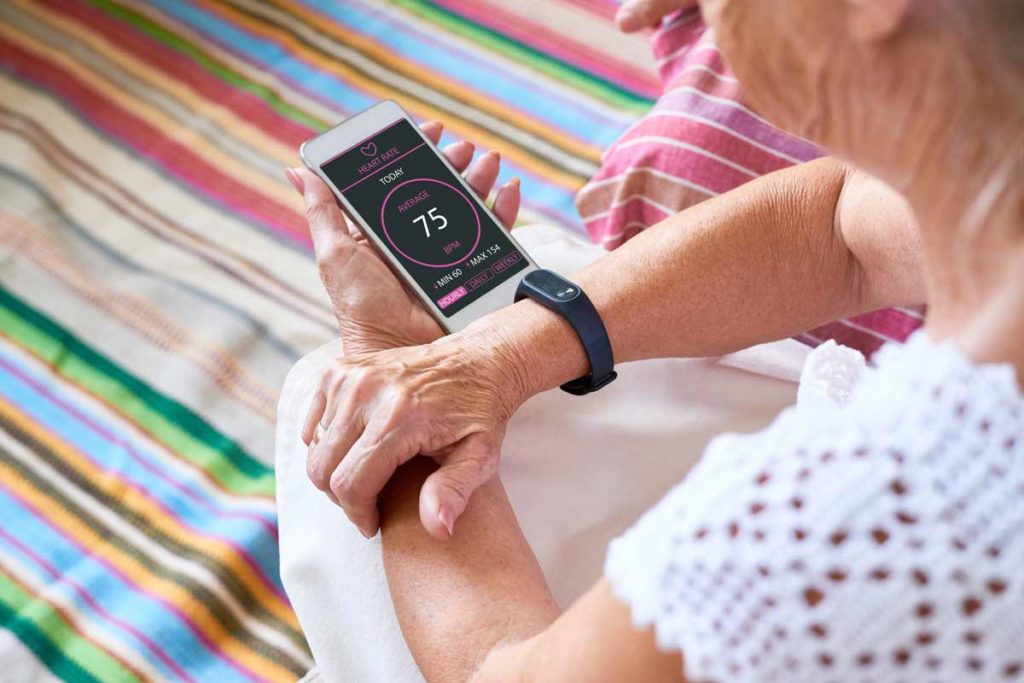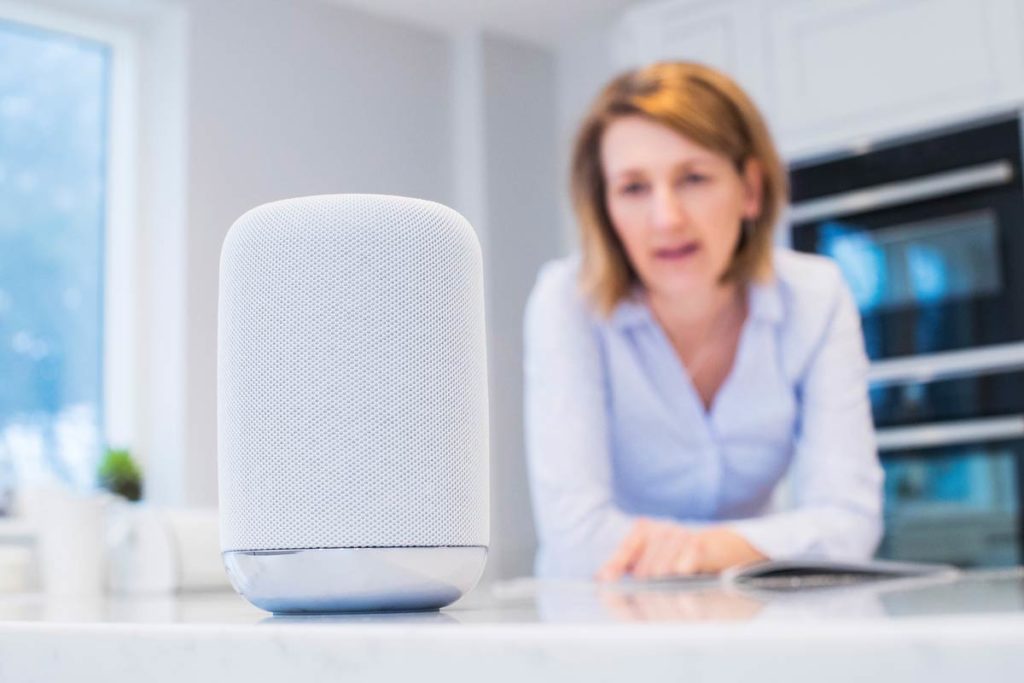If you’re a senior looking to live more independently and comfortably at home, IoT devices might be a great solution to common problems. Healthcare smart devices in particular are one of the fastest growing sectors of IoT, showing tremendous potential to help older adults care for themselves more easily.
What is IoT?
The term IoT means internet of things. An IoT device is one that’s traditionally been “dumb,” or not connected to the internet, but has been redesigned to send and receive data through a Wifi network. IoT devices are called “smart,” as in a smart thermostat or a smartwatch, because they’re internet-enabled.
For example, a traditional water bottle already has purpose: to hold water. However, you can now buy a smart water bottle that tracks how much water you drink each day and sends that data to an app where you can keep track of your intake.
What Are Some Applications of IoT?
So why would you want your thermostat or watch connected to the internet? Here are a few examples of how these smart devices can make life more convenient and efficient.
If you get cold in the night, you can turn up the heat without leaving your bed.
You can access your smart thermostat from your phone. This means if you get cold in the night, you can turn up the heat without leaving your bed. Many smart thermostats also “learn” about your behavior and use this information to conserve electricity.
You can turn on a light by voice command or with your phone. This can help prevent falls by increasing home visibility before you get out of bed at night.
Your smartwatch can help track your sleep at night and steps throughout the day. They come equipped with sensors that detect footsteps and other motions, like tossing and turning while you sleep. You can even program your smartwatch or fitness device to transmit this data to your doctor or nurse so they can help monitor your activity.

You can use a smart speaker like Amazon Echo or Google Home to play music, hear the weather forecast, or even get help with a recipe. For instance you can say, “Google, play the Beatles,” or ask, “Alexa, how many cups is 1 stick of butter?” and the speaker will respond.
You can use a smart fridge to find out the temperature and inventory inside without ever opening the door. A device like this can also show you what you need help make a shopping list for what to buy next.
You can use a smart band or watch to monitor your blood pressure or heart rate. These devices are wearable and can constantly track your vital signs. If these levels veer into a dangerous range, they’ll automatically notify your healthcare provider or an emergency responder.
You can use smart blinds to adjust the amount of sunlight allowed into your room without ever having to leave your chair. This application can be especially helpful for older adults with arthritis or dexterity issues.
You can use a smart pad to help alert a caregiver if you’ve gotten out of bed or to track how you sleep at night. These can be helpful if a patient’s recovering from surgery, for example, and needs help getting around their home.
How Could IoT Be Helpful For Seniors?
Convenience
You may have already gotten a sense of how IoT devices can make life easier for seniors from the previous examples. One of the biggest ways they can help is by making everyday tasks easier. For instance, buying more toilet paper can be as simple as asking your smart speaker to purchase the item and then waiting for it to arrive in the mail. It can also reduce the need to get up in the night, thanks to devices that can turn on a fan or the air conditioning through your phone. Smart cars can help by saving your frequently visited addresses and navigating for you.

Safety
IoT devices can help make independent senior living safer. For example, you or your caregiver could opt to install a motion sensor that alerts a responder if no movement’s been detected over a long period of time. This means help will arrive faster after a fall or illness. IoT devices can also track changes in air quality, temperature, humidity, or carbon monoxide, notifying the homeowner or caregiver if levels fall below an acceptable level.
Healthcare is one of the most promising applications of IoT technology.
Healthcare Applications
Healthcare is one of the most promising applications of IoT technology. Healthcare IoT devices can monitor everything from medication compliance to blood pressure. A senior can purchase an internet-enabled pill box, for instance, to help make sure they’re taking their medication as prescribed. Or a diabetic patient could use a smartwatch to monitor their glucose levels and automatically log them online, no finger prick required. These devices may help seniors live with more independence and peace of mind.
Home Security
Smart devices show potential for improving home security through smart locks, cameras, and sensors. These devices can alert home owners if there’s a break-in or just unusual activity outside their home. They can also help seniors monitor their homes independently, without just relying on a home security company. These users can access camera feeds, open and lock doors, and turn sensors on or off right from their smartphones.
Seniors can also use IoT devices to monitor their smoke alarms and carbon monoxide detectors on their personal devices. They can turn off their smoke alarm from their phone if they’re experiencing a false alarm from a burned dinner, for example, without having to reach the ceiling to deactivate the device itself.
What Conditions Can IoT Help With?
IoT shows tremendous potential to help seniors with chronic health conditions manage these issues without giving up their independence. These are just a few of the ways that IoT technology is making a difference to older adults.

Diabetes
Of all chronic health conditions, diabetes shows perhaps the most potential for an IoT revolution. That’s because many aspects of diabetes require frequent monitoring: glucose, weight, diet, skin, etc. Fortunately for older adults with diabetes, advances in IoT are already making it easier to live with this issue.
A recent “smart sock” came on the market recently to help people with diabetes track their skin temperature. These socks alert patients and their doctors to “hot spots” that could signal inflammation, helping to prevent sores and ulcers before they start. Another promising device is the glucose monitor that resembles a smartwatch and can be used to painlessly track blood sugar levels. Once the glucose levels are evaluated, this data is instantly sent to the user’s phone, where it can be shared with healthcare workers and caregivers.
COPD
Chronic obstructive pulmonary disorder is known for being difficult to treat, but smart devices are helping making managing this condition easier. Seniors with COPD can now buy sensors that help monitor the temperature and air quality of their home, since these factors can exacerbate symptoms if they fall out of the recommend range.
Seniors with COPD can even invest in a smart vest that helps them breathe easier and wirelessly track their progress on an app. Developers are also working on a smart inhaler that helps seniors know how much to shake before each use and alerts them when the medication inside has run out, helping to improve medication compliance.
High Blood Pressure
IoT devices can eliminate the need for seniors to constantly use a cuff to monitor their blood pressure. Instead, they can simply wear a smartwatch or band that tracks it for them. These devices can let users know if their blood pressure’s risen too high. Many of them also act as fitness trackers, logging the number of footsteps taken and sleep logged in order to help improve a user’s overall health.
Heart Disease
This condition can be tough to treat because many patients don’t start feeling unwell until the late stages of the disease. Thankfully, IoT devices can help monitor the heart rate and alert doctors to any issue before it becomes a serious problem.
Not only that, but these devices can alert emergency responders if the patient shows signs of a heart attack, making sure that help arrives quickly.
Arthritis
Many IoT devices that fall into the convenience category can also aid people who experience arthritis. This condition can make simple everyday tasks difficult, but IoT devices are quickly changing that reality. For example, an older adult who struggles with using a lock and key can install a smart lock that lets a user open the door by scanning their fingerprint or typing a code into their smartphone. They can also use a home assistant like the Amazon Echo to set a timer, ask a question, or write lists without having to use a writing utensil.
Many other IoT devices exist to help seniors around their homes. Smart lighting, smart blinds and shades, smart thermostats, and smart refrigerators can all make self-sufficiency possible for even those with advanced arthritis.
Mobility Issues
Many seniors face mobility challenges, but IoT devices are helping to overcome many of those difficulties. Seniors who have trouble moving around their homes can use a smart thermostat and smart lighting to limit the amount of walking they need to do. They can also install a smart doorbell with a camera so they can see who’s at their door without getting up from their seat.
A patient who’s recovering from surgery or on bedrest can install a smart pad in their bed to alert their caregiver if they’ve gotten up and need help getting to the restroom or kitchen.
What You Need To Start Using An IoT Device

If you’ve decided that a smart device is right for you–whether to help manage your health or improve your quality of life–here are a few things you’ll need to have in place before using IoT technology in your home.
If you run into trouble setting yours up, try looking for a how-to video on YouTube or calling a friend to help you.
Wifi
Most IoT devices rely on your home Wifi network to send and receive data. If you haven’t installed a Wifi network in your home, consider calling a local internet provider or ask a friend or relative to help you. Some of these devices stay connected constantly, like smart thermostats or fridges. Others, like those devices worn outside the home, record data that is uploaded whenever you connect to a Wifi network.
Set-Up
Not all of these devices work right out of the box. Most require some amount of set-up, like entering your user data, connecting to your Wifi network, and setting your user preferences. If you run into trouble setting yours up, try looking for a how-to video on YouTube or calling a friend to help you.
Electricity
It may seem obvious, but all of these devices need power to operate. Some home devices, like smart lights or fridges, will remain connected to an outlet consistently. Others, like wearable fitness trackers, will need to be charged periodically. Many come with their own chargers and instructions for how often you’ll need to recharge them.
Growth of IoT Devices

The Internet of Things market has shown incredible growth over the past decade, and analysts expect it to continue growing at impressive rates. Forbes predicts that IoT will grow at a rate of 28.5% a year, keeping it on track to become a $457 billion industry by 2020. They also believe that the fastest growing sector in this field will be consumer electronics, followed by automotive solutions and healthcare and life sciences. This means we’ll likely see even more healthcare devices helping older adults stay healthy and self-sufficient for longer.
Understanding The Risks

As transformative as these devices can be, they also carry risks for consumers. These can include security risks, potential for theft, and accidental purchasing, to name a few. Knowing these potential threats can help seniors protect themselves.
Make sure to manage your purchase settings if you do install one of these devices in your home.
Privacy
Many seniors express concern over the privacy risks that these devices present, and they’re right to be cautious. While these products can make life easier, they can also allow companies to access consumer information in a way never possible before. For example, when you ask your home assistant to make a shopping list or schedule an appointment, this information may be submitted to the manufacturer. Amazon has already faced criticism for listening to consumers’ conversations even when they’re not speaking directly to the device.
Even non-listening devices may be harvesting user data. Your smart lock may record when you leave the house each day or your fitness tracker may observe where you walk. This information could be tracked by companies and used to profile consumers and target them with ads that are specialized to their lifestyle.
Cyber Threats
Adding more internet-enabled devices to your home can increase your risk of being hacked by a third party. That’s because unlike your laptop or smartphone, which probably come with anti-malware, your IoT device may not be equipped with this type of protection.
Power Outages
As much as they help in everyday life, IoT devices can create real problems during a power or internet outage. For example, as convenient as it may be to use a smart lock on your house, a power outage can cause the whole system to stop working. The same goes for smart household devices like smart blinds, smart fridges, and smart thermostats. Always have a back-up plan in place for these products.
Accidental Purchasing
Home assistant devices like Amazon Echo or Google Home can help seniors shop for home basics like paper towels or laundry detergent without leaving home. However, these devices have been known to make online ordering a little too easy, even misinterpreting some regular conversations for purchase commands. Some parents and grandparents even report that their children were able to buy things without permission. Make sure to manage your purchase settings if you do install one of these devices in your home.
Potential For Theft
Of course these devices add value to your home, and criminals are very aware of this added value. For this reason, it’s even more important to protect your home if you own several of these valuable and in-demand products. Consider beefing up your home security system if you’ve added expensive IoT devices to your house. Always keep these appliances away from windows where they can be observed by thieves.
How To Protect Yourself
Passwords
Always use strong, hard-to-guess passwords. These can include capitalized letters, numbers, and odd characters. Never use easy passwords like a pet’s name or consecutive numbers like “12345,” and never leave usernames and passwords on the default factory settings. These mistakes make it much easier for a hacker to access your network. Also, try to avoid writing down your passwords. If you have several to keep track off, try using a password manager like LastPass or 1Password.
It’s tempting to use public Wifi while in a public space. However, while it may save you data on your phone plan, it puts your device at serious risk of hacking.
Phishing Scams
Avoid answering any email that asks for your personal information, like your passwords, date of birth, or family members’ names. Some hackers will try to pose as employees from legitimate businesses–such as your bank or health insurance company–but just realize that the real companies will never email you out of the blue to ask for this information.
Install Anti-Malware On Your Phone And Computer
Securing your phone and computer is the most important step in protecting your smart objects, since many of them are controlled by these devices. They act as virtual gatekeepers for your home. The myth that Apple products–like MacBook computers and iPhones–don’t need antivirus protection has been circulating for years, but experts say that’s just not true. No matter what brand or model device you use, you’ll need to secure it with a quality antivirus software. Once you’ve installed it, make sure to keep up with each update issued by the company.
Don’t Use Public Wifi
It’s tempting to use public Wifi while in a public space. However, while it may save you data on your phone plan, it puts your device at serious risk of hacking. This, in turn, can put all your IoT products at risk. If you need to access the internet on your laptop while away from home, try turning on your smartphone’s hotspot feature instead. Most phones come standard with this feature, but you may need to ask your service provider to turn your hotspot on for you.
Weighing The Pros and Cons

With all the factors involved, adding IoT devices to your lifestyle may feel like a big decision. Here are some questions to consider when deciding whether or not to make your home a smart home.
- Will the convenience of these devices be worth the risk?
- How much support will I have–whether professional or casual–in setting up and maintaining these devices?
- Will these devices help me to live more independently?
- What will my learning curve be like when I start to use smart products?
- Will it save me money in the long-run?
- Could it improve my health?
When it comes to independent senior living, the IoT field is one of the most exciting developments on the market.
Conclusion
When it comes to independent senior living, the IoT field is one of the most exciting developments on the market. With remote monitoring health devices, seniors can easily track their medical conditions while going about their lives. With smart beds, blinds, and lights, they can navigate their homes more confidently. With smart motion sensors and smart smoke detectors, they can feel safer and more secure.
Some seniors may be hesitant to adapt to these new devices due to the risks. However, once they’ve experienced the convenience and self-sufficiency this technology brings, they may start considering them indispensable.
Do you want to cite this page? Use our ready-made cite template.
